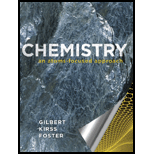
To find
The increasing order of boiling point of aqueous solution of
(i =
Answer to Problem 11.55QA
Solution
The increasing order of boiling points of given aqueous solutions is
a)
Explanation of Solution
1. Concept:
Using boiling point of elevation we can find out the boiling point of the aqueous solution.
We can use molality and van’t Hoff factor to calculate the boiling point of the solution.
2. Formula:
The boiling point of elevation is
3. Given:
i. The Kb of water =
ii. The normal boiling point of water (solvent) =
iii. Molality of FeCl3 =
iv. Molality of MgCl2 = 0.10 m (i =
v. Molality of KCl = 0.20 m (i =
4. Calculations:
We will calculate the boiling point of each aqueous solution.
a) Boiling point of aqueous solution of
The boiling point elevation:
To calculate the boiling point of aqueous solution of FeCl3, we add
b) Boiling point of aqueous solution of
The boiling point elevation:
To calculate the boiling point of aqueous solution of MgCl2, we add
c) Boiling point of aqueous solution of
The boiling point elevation:
To calculate the boiling point of aqueous solution of KCl, we add
Boiling points of each aqueous solution are
This means
Therefore, the increasing order of boiling points of given aqueous solutions is
a)
Conclusion
Elevation in the boiling point can be used to find out the boiling point of a solution using the normal boiling point of pure solvent.
Want to see more full solutions like this?
Chapter 11 Solutions
Chemistry: An Atoms-Focused Approach
 ChemistryChemistryISBN:9781305957404Author:Steven S. Zumdahl, Susan A. Zumdahl, Donald J. DeCostePublisher:Cengage Learning
ChemistryChemistryISBN:9781305957404Author:Steven S. Zumdahl, Susan A. Zumdahl, Donald J. DeCostePublisher:Cengage Learning ChemistryChemistryISBN:9781259911156Author:Raymond Chang Dr., Jason Overby ProfessorPublisher:McGraw-Hill Education
ChemistryChemistryISBN:9781259911156Author:Raymond Chang Dr., Jason Overby ProfessorPublisher:McGraw-Hill Education Principles of Instrumental AnalysisChemistryISBN:9781305577213Author:Douglas A. Skoog, F. James Holler, Stanley R. CrouchPublisher:Cengage Learning
Principles of Instrumental AnalysisChemistryISBN:9781305577213Author:Douglas A. Skoog, F. James Holler, Stanley R. CrouchPublisher:Cengage Learning Organic ChemistryChemistryISBN:9780078021558Author:Janice Gorzynski Smith Dr.Publisher:McGraw-Hill Education
Organic ChemistryChemistryISBN:9780078021558Author:Janice Gorzynski Smith Dr.Publisher:McGraw-Hill Education Chemistry: Principles and ReactionsChemistryISBN:9781305079373Author:William L. Masterton, Cecile N. HurleyPublisher:Cengage Learning
Chemistry: Principles and ReactionsChemistryISBN:9781305079373Author:William L. Masterton, Cecile N. HurleyPublisher:Cengage Learning Elementary Principles of Chemical Processes, Bind...ChemistryISBN:9781118431221Author:Richard M. Felder, Ronald W. Rousseau, Lisa G. BullardPublisher:WILEY
Elementary Principles of Chemical Processes, Bind...ChemistryISBN:9781118431221Author:Richard M. Felder, Ronald W. Rousseau, Lisa G. BullardPublisher:WILEY





